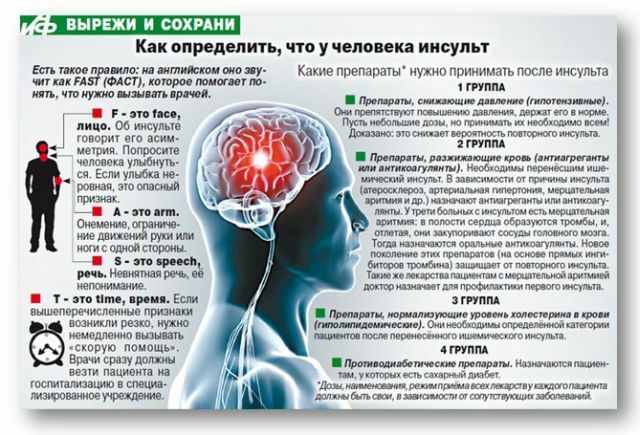Craniotomy stroke is often the only way to save the patient's life in hemorrhagic form of pathology. The disease is accompanied by intracranial hemorrhage, case because of damage to arteries. Hematoma has different dimensions, it compresses the surrounding tissues, causing severe neurological disorders. Surgical treatment is indicated for larger sizes hematoma.

Indications and contraindications to
craniotomy refers to emergency surgery, which is carried out at:
- increased intracranial pressure;
- pronounced edema of brain tissue;
- the presence of large hematomas;
- thrombosis and atherosclerosis of cerebral arteries;
- the presence of cancer;
- accession of infections and inflammatory processes;
- the need to remove tissue for histological examination.
In some cases, the operation is dangerous to the health and life of the patient. The list of contraindications to craniotomy include:
- severe hypertension;
- transferred within the last 6 months of operation in the intracranial space;
- acute and chronic decompensated heart failure;
- severe disease of the central nervous system;
- senile age (in this case the operation is carried out only with drug therapy intractable, life threatening conditions);
- exacerbation of chronic diseases of internal organs;
- late stages of cancer pathologies;
- purulent lesions, accompanied by necrosis of the soft tissue.

Training
Preparation for trepanation hemorrhagic type of stroke include:
- Examination. Before the operation, hand over blood and urine tests. Evaluated qualitative and quantitative composition and blood clotting, revealed signs of inflammatory diseases, could become a contraindication to intervention. Indications for operation is detected by CT or MRI of the brain. To evaluate the cardiovascular system is carried ECG functions.
- Failure of the medication. 2 weeks before the procedure, the physician cancels drugs that can provoke postoperative complications. These include anticoagulants and antiplatelet agents that reduce blood clotting. On the day of the procedure by refusing all medications.
- The refusal of the meal the day before the intervention. On the day of the operation is not allowed and the use of a liquid.
- consultation of a neurosurgeon. The doctor tells the patient about the chosen method of treatment and possible risks. At this stage, we study the history of the disease.

How do trepanation
Depending on the size of the lesion and the patient's general state of operation can take from 5 to 10 hours. Plan for the surgery involves the following steps:
- patient training. Intravenously administered drugs for general anesthesia, and then the tracheal intubation. the patient's head is fixed by means of a special device, the retaining skull upright. This allows you to completely immobilize the operated area in the performance of surgical procedures. At this stage set lumbar drainage required for removing cerebrospinal fluid. Sometimes the pressure of the cerebrospinal fluid is reduced with medication.
- skin incision. Operating wound runs along the hairline. The risk of cosmetic defects after the intervention of trying to minimize. The skin flap is separated from the cranial bones.
- An autopsy of the skull. Drill several small holes made. With medical saws cut bone flap desired size. It is stored throughout the surgery for subsequent return to the site.
- Gaining access to the brain substance. The surgeon wears glasses with the operating microscope, and then makes an incision in the dura mater. Body impacted the skull, so it is impossible to move him cloth. Neurosurgeon to perform manipulations using fine instruments introduced into the brain thickness. Necrosis or hematoma is removed, the intervention is combined with continuous monitoring of the cranial nerves and the cardiovascular system.
- Closing the skull defect. The cut bone flap is returned to its previous position fix, or metal straps. Incision sutured, and then impose a sterile bandage.

Effects
Craniotomy after a stroke can cause the following complications:
- intracranial hemorrhage;
- brain tissue edema;
- seizures;
- attachment of bacterial infections;
- tissue injury or cerebral blood vessels;
- full or partial limb paralysis;
- speech impairment;
- memory impairment;
- violation of the processes of perception and memorizing new information;
- severe headaches, nausea and vomiting (early postoperative pain eliminate narcotic analgesics);
- availability of cosmetic defects associated with the removal of bone flap (to solve this problem helps cranioplasty);
- impairment of the function of the digestive and respiratory systems;
- muscle weakness.
Rehabilitation after craniotomy includes:
- It is in the intensive care unit (within the first 2 days you want to track performance of the brain and heart);
- care of the operating wound (dressing change every day, the wound is treated with antiseptic solutions, sutures are removed after 10-14 days);
- adherence to a special diet (the patient should eat easily digestible foods, do not disturb the intestinal motility);
- physical therapy sessions (to help avoid stagnation of blood and lymph flow caused by prolonged immobilization);
- drug therapy (currently used nootropics and neuroprotective normalizing cerebral functions).
Disability after craniotomy is assigned in the presence of severe consequences of stroke, and the operation itself.
Related publications:
- spinal cord stroke
- Symptoms and signs of myocardial ischemia in the legs microstroke women (men) elderly
- The first signs (symptoms) of the brain of stroke or cerebrovascular accidents
- How to treat hemorrhagic stroke and cerebral symptoms (effects), intracerebral hemorrhage



